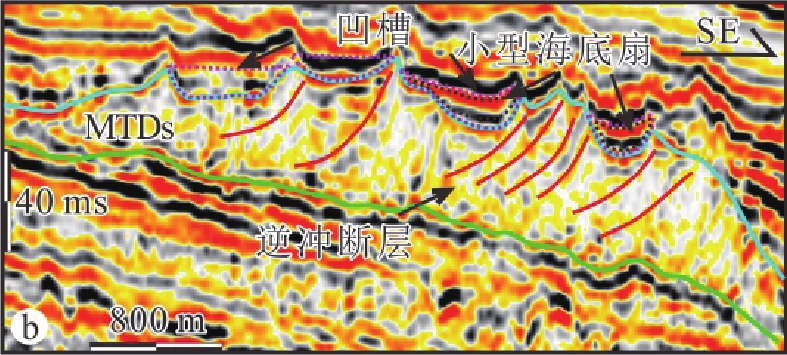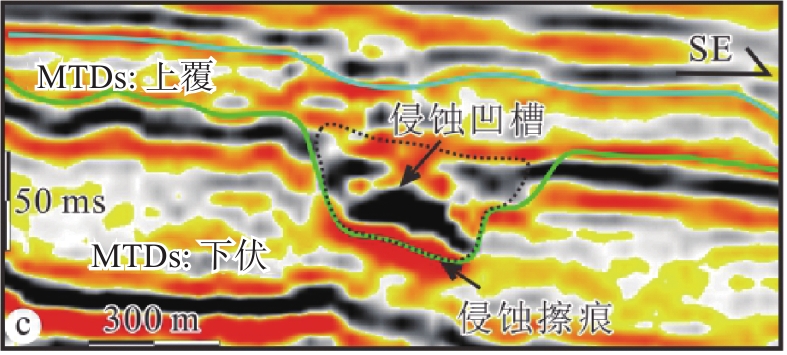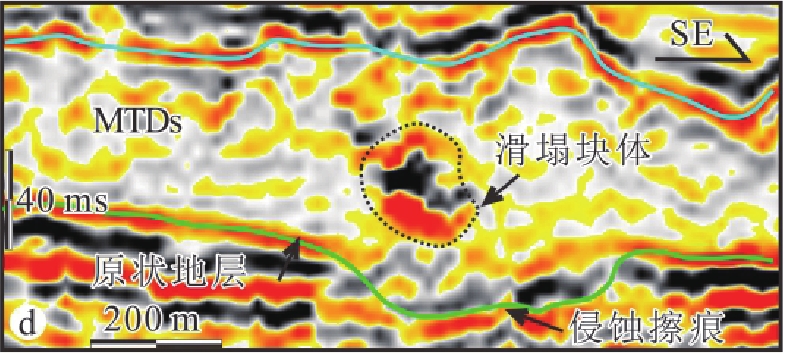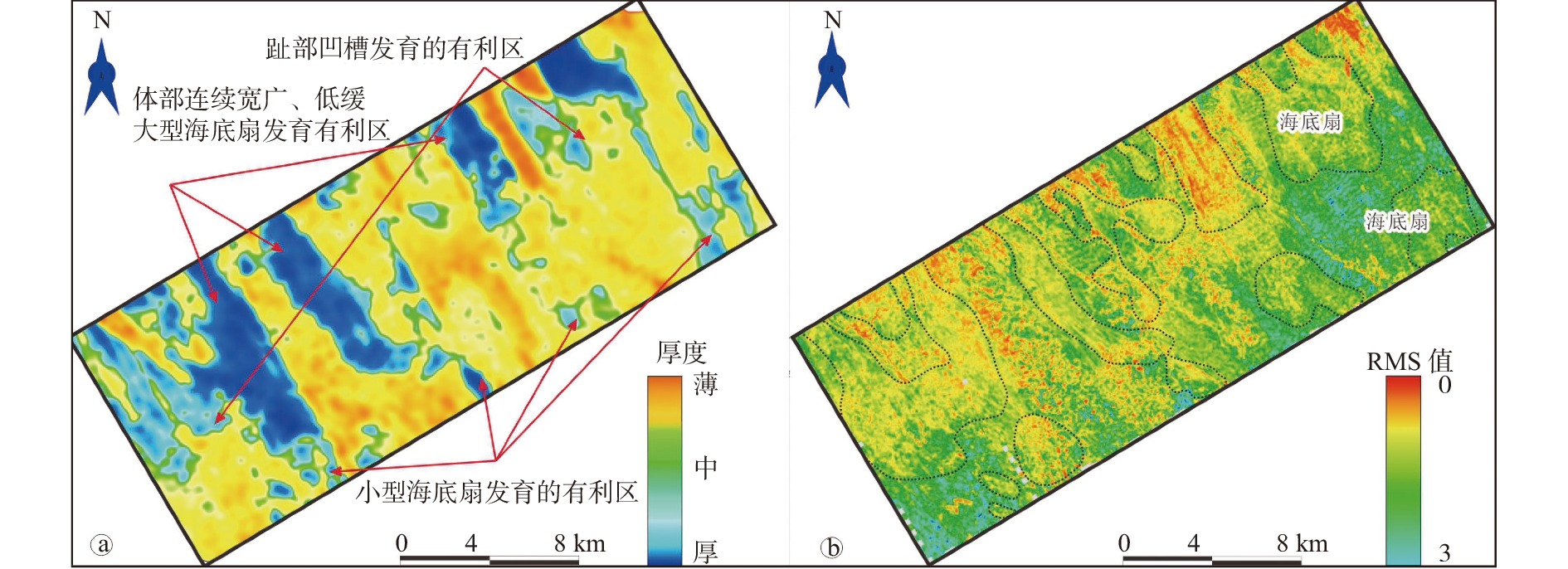Numerical simulation of post-mass transport deposition: a case study of the margin slope of South China Sea
-
摘要:
块体搬运沉积体系(MTDs)具有起伏不平的顶面,会影响后续的浊流沉积,厘清MTDs顶面对后续沉积的控制作用,有助于了解海底扇的发育规律。基于南海北部琼莺段陆坡的三维地震数据,对块体搬运沉积体系及其上覆充填物的形态进行刻画,并使用Flow3D进行数值模拟,分析其顶面对后续沉积的影响。研究认为:①MTDs的体部顶面具有低平、宽缓的特点,可形成宽广低缓的凹槽;趾部挤压区顶面起伏大,可形成孤立的凹槽。②MTDs体部顶面可形成大规模的、连续的海底扇;趾部顶面凹槽发育小型扇体;局部隆起的背流面下端可发育规模不一的扇体;MTDs末端低洼处是大型海底扇形成的有利区。③MTDs顶面起伏程度越大,越有利于沉积物卸载、沉积,形成更大规模海底扇。
Abstract:The mass transport deposits (MTDs) have largely-undulating top surface, which would affect post-MTD turbidity currents deposition and distribution. A systematic study on the MTD deposition is helpful for interpreting the deposit pattern of submarine fan. Based on 3D seismic data in the Qiongying continental slope of the northern South China Sea, the MTD sedimentary system, and its overburden deposits, and the impact of the top surface on post-MTD sedimentation were numerically simulated using the Flow3D. Results show that: ① the top surface of translational domain is flat and gentle, on which distributed broad-gentle troughs; and the top surface of the toe domain fluctuates greatly, forming an isolated troughs. ② On the top surface of the translational domain forms a large and continuous submarine fan, while a small submarine fan can form in the toe domain; the slip slope of local uplift can develop different-sized submarine fans. The terminal domain is a favorable area for large submarine fans formation. ③ The greater relief of the top surface, the more conducive to sediment unloading and deposit, and the larger submarine fan formation.
-

-
表 1 MTDs识别标志
Table 1. Identification standards of MTDs
沉积单元类型 地震剖面特征 地质模式 特征 正断层 

发育在头部,由较连续的蠕虫状反射过渡为杂乱反射 逆冲断层 

发育在趾部,体部前端,挤压形成逆冲断层,上覆常见凹槽 侵蚀擦痕 

发育在体部,MTDs切割下伏地层,可见侵蚀凹槽 滑塌块体 

发育在体部,孤立地质体出现杂乱反射中,下伏常见侵蚀凹槽 注:剖面位置见图1a。 表 2 沉积数值模拟边界条件
Table 2. Boundary conditions of the numerical simulation
参数项 设定值 浊流初始流速/(m/s) 1~10 颗粒粒径/mm 0.5(砂岩)、0.04(粉砂)、0.005(黏土) 密度/(g/cm3) 500(砂岩)、2 200(粉砂岩)、1 800(黏土) 重力加速度/(m/s2) 9.81 陆坡坡度/(°) 2 模拟时间步长/s 2 网格大小/m 0.5×0.5×0.5 -
[1] NWOKO J,KANE I,HUUSE M. Mass transport deposit (MTD) relief as a control on post-MTD sedimentation:insights from the Taranaki Basin,offshore New Zealand[J]. Marine and Petroleum Geology,2020,120:104489. doi: 10.1016/j.marpetgeo.2020.104489
[2] 刘铮,陈端新,朱友生,等. 基于水下自主航行器(AUV)的神狐峡谷谷底块体搬运沉积特征及其对深水峡谷物质输运过程的指示[J]. 海洋地质与第四纪地质,2021,41(2):13-21. doi: 10.16562/j.cnki.0256-1492.2020110301
[3] 王大伟,吴时国,秦志亮,等. 南海陆坡大型块体搬运体系的结构与识别特征[J]. 海洋地质与第四纪地质,2009,29(5):65-72.
[4] 杜浩,石万忠,梁金强,等. 琼东南盆地块体搬运沉积体系成因及其对水合物成藏的影响[J]. 石油地球物理勘探,2021,56(4):869-881,676. doi: 10.13810/j.cnki.issn.1000-7210.2021.04.020
[5] BULL S,CARTWRIGHT J,HUUSE M. A review of kinematic indicators from mass-transport complexes using 3D seismic data[J]. Marine and Petroleum Geology,2008,26(7):1132-1151.
[6] 秦雁群,万仑坤,计智锋,等. 深水块体搬运沉积体系研究进展[J]. 石油与天然气地质,2018,39(1):140-152.
[7] 李磊,王英民,徐强,等. 南海北部白云凹陷21Ma深水重力流沉积体系[J]. 石油学报,2012,33(5):798-806. doi: 10.7623/syxb201205008
[8] 唐常锐,徐秀刚,孙秉才,等. 天然气水合物分解诱发海底滑坡影响因素分析及致灾风险评价[J]. 海洋地质前沿,2021,37(5):14-21. doi: 10.16028/j.1009-2722.2021.021
[9] 李林,张成,闫春,等. 琼东南盆地华光凹陷大型海底重力滑动系统特征及其成因机制[J]. 地球科学,2021,46(10):3707-3716.
[10] BROWNE G H,BULL S,ARNOT M J,et al. The role of mass transport deposits contributing to fluid escape:Neogene outcrop and seismic examples from north Taranaki,New Zealand[J]. Geo-Marine Letters,2020,40(5):1-19.
[11] KNELLER B,DYKSTRA M,FAIRWEATHER L,et al. Mass-transport and slope accommodation:implications for turbidite sandstone reservoirs[J]. AAPG Bulletin,2016,100(2):213-235. doi: 10.1306/09011514210
[12] 孙启良,解习农,吴时国. 南海北部海底滑坡的特征、灾害评估和研究展望[J]. 地学前缘,2021,28(2):258-270. doi: 10.13745/j.esf.sf.2020.9.3
[13] 王俊勤,张广旭,陈端新,等. 琼东南盆地陵水研究区海底地质灾害类型、分布和成因机制[J]. 海洋地质与第四纪地质,2019,39(4):87-95. doi: 10.16562/j.cnki.0256-1492.2018052303
[14] 王海荣,王英民,邱燕,等. 南海北部陆坡的地貌形态及其控制因素[J]. 海洋学报(中文版),2008,30(2):70-79. doi: 10.3321/j.issn:0253-4193.2008.02.009
[15] TANABE S,HORI S,SAITO Y,et al. Song Hong (Red River) Delta evolution related to millennium-scale Holocene sea-level changes[J]. Quaternary Science Reviews,2003,22(21):2345-2361.
[16] 朱友生,王艳秋,冯湘子,等. 琼东南盆地陵水17-2深水气田开发区表层沉积物类型及工程地质特性[J]. 海洋地质与第四纪地质,2022,42(1):45-56. doi: 10.16562/j.cnki.0256-1492.2020120601
[17] 蒋卫威,鱼京善,陈寅生,等. 基于FLOW3D的梅溪洪濑段桥梁雍水三维数值模拟[J]. 南水北调与水利科技,2021,19(4):776-785.
[18] HSU S K,KUO J,LO C L,et al. Turbidity currents,submarine landslides and the 2006 Pingtung Earthquake off SW Taiwan[J]. Terrestrial,Atmospheric and Oceanic Sciences,2008,19(6):767-772. doi: 10.3319/TAO.2008.19.6.767(PT)
[19] HUANG H,IMRAN J,PIRMEZ C. Numerical modeling of poorly sorted depositional turbidity currents[J]. Journal of Geophysical Research,2007,112:1-15.
[20] 高仁祖, 吴海涛, 顾声龙, 等. 台阶式溢洪道的δ-LES-SPH数值模拟[J/OL]. 计算力学学报, 2022:1-10. Doi. 10.13673/j. cnki. cn37-1359/te. 202201022.
-




 下载:
下载:




